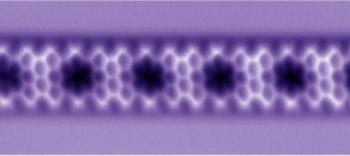Scientists at the University of Basel have managed to synthesize boron-doped graphene nanoribbons and characterize their structural, electronic and chemical properties. The modified material could potentially be used as a sensor for ecologically damaging nitrogen oxides.

Altering graphene sheets to nanoribbon shape is known as a way of inducing a bandgap, whose value is dependent on the width of the shape. To tune the band gap in order for the graphene nanoribbons to act like a silicon semiconductor, the ribbons usually undergo doping. That means the researchers intentionally introduce impurities into pure material for the purpose of modulating its electrical properties. While nitrogen doping has been realized, boron-doping has remained unexplored. Subsequently, the electronic and chemical properties have stayed unclear thus far.
The team at Basel University, assisted by researchers from Japanese and Finnish Universities, have succeeded in synthesizing boron-doped graphene nanoribbons with various widths. They used an on-surface chemical reaction with a newly synthesized precursor molecule on an atomically clean gold surface. The chemical structures were directly resolved by state-of-the-art atomic force microscopy at low temperature.
The doped site of the boron atom was confirmed and its doping ratio was at 4.8 atomic percent. By dosing nitric oxide gas, the chemical property known as the Lewis acidity could also be confirmed. The doped nitric oxide gas was highly-selectively adsorbed on the boron site. This measurement indicates that the boron-doped graphene nanoribbon can be used for an ultra-high sensitive gas sensor for nitrogen oxides which are currently a hot topic in the industry as being highly damaging to the environment.